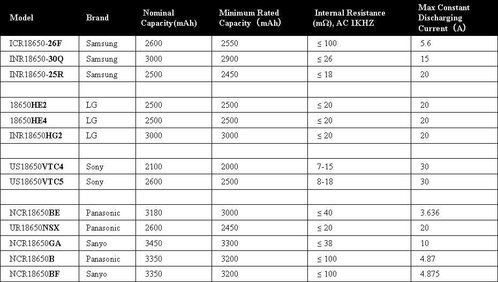Navigation
Install the app
How to install the app on iOS
Follow along with the video below to see how to install our site as a web app on your home screen.

Note: this_feature_currently_requires_accessing_site_using_safari
More options
You are using an out of date browser. It may not display this or other websites correctly.
You should upgrade or use an alternative browser.
You should upgrade or use an alternative browser.
.
I asked Mooch (on ECF) if the internal resistance of batteries played any role in his battery ratings and this was his reply:
Directly? None.
But IR is the cause of the battery sag that determines the performance of the battery. It is also what heats up the battery and its temperature is hugely important in setting the rating.
I measure the IR of all the batteries I test but the data is not included in the test report. I use to but the number of questions and the misunderstanding of what the IR really meant was overwhelming.
I may add IR back in some time in the future after I, eventually, put up a video about it.
.
I asked Mooch (on ECF) if the internal resistance of batteries played any role in his battery ratings and this was his reply:
Directly? None.
But IR is the cause of the battery sag that determines the performance of the battery. It is also what heats up the battery and its temperature is hugely important in setting the rating.
I measure the IR of all the batteries I test but the data is not included in the test report. I use to but the number of questions and the misunderstanding of what the IR really meant was overwhelming.
I may add IR back in some time in the future after I, eventually, put up a video about it.
.
Im assuming these are obviously new batteries full charged?
And the lower the milliohms the better?
Sorry if I sound dumb... lol
Sent from my iPhone using Tapatalk
Yeah, seems as if that's the case.
.
Thanks @ddk1979 , very informative and appreciate the share and the question and amswer from Mooch.
@Mac75 - i doubt internal resistance has much to do with being fully charged or flat, but i could be wrong
I thought its more a function of the chemistry and the age. @johan, what you think of this?
Lower is better.
@Mac75 - i doubt internal resistance has much to do with being fully charged or flat, but i could be wrong
I thought its more a function of the chemistry and the age. @johan, what you think of this?
Lower is better.
Thanks @ddk1979 , very informative and appreciate the share and the question and amswer from Mooch.
@Mac75 - i doubt internal resistance has much to do with being fully charged or flat, but i could be wrong
I thought its more a function of the chemistry and the age. @johan, what you think of this?
Lower is better.
apologies, been away on holiday - You're correct; although there will be a minor change in internal resistance of a fully charged and a discharged battery (its minute), the internal resistance change comes into play as the battery ages (higher internal resistance at near-end-of-life). The internal resistance will also increase when the battery is misused, i.e: overcharged (>4.20V) and over-discharged (<2.5V - depending on manufacturer specifications). What actually happens in a nutshell is that the copper electrode at the anode side (- side) starts to dissolve into the internal electrolyte and during each following charge cycle plates onto the internal separator (insulator between cathode and anode side). With less copper on the anode there is less conductivity resulting in higher internal resistance.
Discovered that in the SONY VTC6, the IR is between 8 and 12 mΩ. The upper limit is the lowest of all the batteries in the table above.
Mooch rates this battery as the best 18650 and the IR seems to tie in with his rating.
.
Mooch rates this battery as the best 18650 and the IR seems to tie in with his rating.
.
Similar threads
- Replies
- 3
- Views
- 864
- Replies
- 4
- Views
- 2K
- Replies
- 1
- Views
- 452




